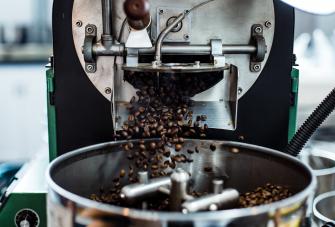Coffee Shop Organizational Structure: Building Efficiency
Coffee, a universally adored beverage, amassed a staggering $88.3 billion in global revenue [1] this year, captivating aficionados worldwide with its myriad forms—be it cappuccino, espresso, or Americano. This brew embodies sentiments of love, inspiration, and luxury.
When embarking on a café venture, the pivotal aspect to contemplate is its organisational framework. Crafting a pragmatic structure lays the foundation for contented patrons, efficient strategising, harmonious teamwork, and a streamlined workflow. With this in mind, we'll delve into the café's organisational structure, its significance, illustrative examples, the process of creation, and actionable tips for implementing this structure in your coffee enterprise.
What is a coffee shop organisational chart?
An organisational chart for coffee shops serves as a visual roadmap, delineating the roles and responsibilities of every individual within an organisation. It's a vital tool, clarifying duties and empowering employees to work with heightened motivation and focus.
This principle holds true for coffee shops and espresso bars, where a well-defined organisational structure is essential for seamless operations. A coffee shop business org chart maps out the hierarchy and functions of shop personnel, enhancing communication lines and clarifying reporting structures.
Whether small or large-scale, a coffee business encompasses various roles: owner, accountant, cooks, assistant cooks, head waiter, assistant waiters, baristas, and dishwashers, among others. A defined hierarchy ensures a smooth chain of command, enabling employees to report to their superiors without confusion.
The coffee shop's organisational chart should be easily accessible, ideally displayed on the shop's notice board, serving as a constant reminder of each individual's daily duties and responsibilities.
Benefits of an organisational chart
Creating an organisation chart for your coffee shop yields numerous advantages, steering your business toward efficiency and clarity:
- Fostering a collaborative work environment: A well-coordinated organisational structure nurtures teamwork, encouraging personnel to collectively fulfil their responsibilities within an interactive setting.
- Clear role definition: Org charts delineate each employee's role, clarifying their responsibilities and expected contributions.
- Streamlined chain of command: With a defined structure, employees know precisely whom to approach for guidance or in case of issues, ensuring a smoother chain of command.
- Effective workload management: A robust organisational chart enables efficient distribution of tasks, a crucial factor in successful business operations.
- Enhanced employee relationships: Proper workforce distribution, as outlined in the coffee shop org chart, fosters stronger employee bonds and facilitates timely task completion.
- Motivated task execution: Functionality-based task allocation allows workers to approach their responsibilities with heightened motivation, boosting productivity.
- Preventing monopolisation: Clear delineation of duties reduces the likelihood of one person overstepping their responsibilities, promoting fairness, wellbeing, and accountability.
Increased productivity and customer trust: A professionally structured org chart contributes to heightened productivity, leading to improved customer satisfaction and, subsequently, increased revenue for your coffee shop.
Coffee shop organisational structures
The organisational structure within most coffee shops typically follows a "Matrix" framework, incorporating both vertical and horizontal hierarchies that align with functional requirements. Vertical relationships may stem from various parameters, such as product, project, region, or function.
To understand a general coffee shop's organisational structure, consider the following functional hierarchy breakdown of its workforce:
- Owner: The proprietor of the shop holds ownership of the business. Rather than directly controlling or monitoring activities, they receive reports on the business's day-to-day operations.
- Administrator: Reporting to the owner, the administrator oversees ongoing and potential activities, and managers, to ensure effective performance.
- Manager: Managers oversee various shop operations, from resource and project management to financial oversight. In larger business circles, multiple managers may handle distinct areas. They also supervise working staff, including cooks, waiters, and cashiers, addressing any issues or bottlenecks.
- Assistant restaurant manager: Assistant managers monitor the assistant staff, such as junior waiters, assistant cooks, and dishwashers, sharing managerial responsibilities.
- Accountant: Responsible for monitoring financial affairs, including sales, taxes, revenue, transactions, profit and loss, and cash management.
- Cooks (executive chef): These professionals prepare coffee and, in some instances, other dishes like pastries or biscuits, supervised by the manager. You will find this role in other businesses like restaurants.
- Assistant cooks: Assistants support the head cook in preparing supplementary dishes like biscuits, cookies, pastries, and cakes.
- Senior waiters: In mid-sized coffee shops, senior waiters supervise junior staff and provide guidance on customer service and table etiquette.
- Junior waiters: Their primary role involves serving coffee and other treats to customers, with smaller coffee shops employing three to five junior waiters.
- Baristas: Known as "Coffee Artists," these individuals embellish coffee with cream and other delightful ingredients, presenting it in various appealing ways to customers.
- Dishwashers: Dedicated to washing cutlery and cookware used in coffee preparation.
- Sweepers and assistants: Assigned to tasks like table and floor cleaning post-customer departure, returning crockery for washing, and organising utensils and cafe equipment.
TIP: Check out our full coffee shop business checklist to see what your staff will need.
What factors influence the organisational structure?
Several factors significantly impact the formation of a business's organisational structure, shaping its pattern in various ways. In the context of your coffee shop, here are some influential factors to consider:
- Business size: The scale of your business plays a crucial role in determining the organisational structure. For instance, a small-scale operation often benefits from a flat organisational structure, while a growing enterprise might require a hierarchical setup to manage increased complexities.
- Staff numbers: The number of coffee shop employees directly influences the complexity of the organisational structure. A smaller team might necessitate a simpler hierarchy, whereas a larger staff count may warrant a more intricate organisational framework.
- Customer base: Understanding and accommodating the volume of customers your coffee shop business serves is pivotal. A higher customer count often demands a larger workforce, potentially prompting the adoption of a hierarchical structure to manage increased service demands.
- Product demand: Aligning your structure with product focus is crucial. A divisional organisational structure may suit a product-centric approach. Extensive market research, such as identifying popular coffee flavours in specific areas and the global market share, aids in tailoring your structure to meet customer demands effectively.
How to create an organisational structure
Establishing an effective organisational structure for your coffee shop is pivotal for smooth operations and team synergy. Follow these steps to create a structure that aligns with your business needs:
- Define business objectives: Start by outlining your coffee shop's goals and objectives. Determine the key functions and areas crucial for achieving success, whether it's exceptional customer service, product innovation, or operational efficiency.
- Assess business size and scope: Evaluate the size and scope of your coffee shop. Consider factors like staff numbers, customer volume, and the range of products/services offered. This assessment will guide the complexity of your structure.
- Identify roles and responsibilities: Define the various roles needed to run your coffee shop effectively. From owners and managers to baristas and cleaning staff, outline the responsibilities and reporting lines for each role.
- Determine hierarchical levels: Decide on the hierarchy within your organisation. For smaller shops, a flat structure might be suitable, whereas larger establishments may require multiple managerial levels to oversee different departments.
- Consider functional areas: Divide your coffee shop into functional areas, such as management, customer service, kitchen operations, and cleaning. Assign roles based on specialised functions within these areas.
- Balance centralisation vs. decentralisation: Find the right balance between centralisation (decision-making at the top) and decentralisation (delegated decision-making across levels). This balance impacts communication flow and decision authority within your shop.
- Establish reporting lines: Create clear reporting lines to ensure smooth communication and accountability. Determine who reports to whom, streamlining the flow of information and responsibility.
- Flexibility and adaptability: Keep your organisational structure flexible to adapt to changes. Business growth, shifts in customer preferences, or staffing alterations may require structural adjustments over time.
- Communicate and train: Once the structure is in place, communicate it clearly to your team. Provide training if needed to ensure everyone understands their roles, responsibilities, and reporting lines.
- Regularly review and revise: Periodically review your organisational structure. Assess its effectiveness in meeting business goals and adapt it as necessary to address any evolving needs or challenges.
Creating an organisational structure for your coffee shop involves thoughtful planning and consideration of various factors. Tailoring the structure to your specific business dynamics ensures efficient operations and a conducive work environment for your team.
A cafe POS that makes selling smoother
Train new staff in just 15 minutes on a cafe POS system that caters to all your needs. No headaches. No hold-ups. Just simple, effective trading.
Enhancing organisational structure with a coffee shop POS
A Point of Sale (POS) system serves as a cornerstone for fortifying and optimising the organisational structure within a coffee shop in several ways:
- Efficient operations management: The cafe POS system streamlines daily cafe operations, aligning with defined roles and responsibilities within the organisational structure. It facilitates seamless communication and coordination between different functional areas.
- Clear role alignment: Each staff member's role becomes well-defined and integrated into the system. Baristas, cooks, waitstaff, and managers can efficiently perform their duties based on the hierarchical structure and clearly outlined responsibilities within the POS framework.
- Streamlined workflow: By tracking orders, inventory, and sales, the POS system ensures a smooth workflow. It helps maintain a structured chain of command, guiding the flow of tasks and communication from front-of-house to back-of-house operations.
- Data-driven decision-making: Comprehensive reports and analytics assist managers and owners in making informed decisions. This data-driven approach aligns with the organisational structure, allowing for strategic planning and better resource allocation.
- Optimal resource allocation: Insights from sales data and inventory management aid in optimising resource allocation. This aligns with the hierarchical structure by ensuring that resources, including staff and inventory, are utilised effectively in line with organisational goals.
- Adaptability and scalability: Modern POS systems offer scalability and adaptability to accommodate business growth. This flexibility aligns with the organisational structure by supporting changes in staff numbers, expanded product lines, payment processing methods, or new business locations.
Brew-tifully organised: final thoughts on coffee shop structures
Crafting a well-structured coffee shop isn't just about brewing the perfect cup. It's about blending roles, responsibilities, and systems seamlessly. Like a well-roasted bean, a finely-tuned organisational structure can enhance the flavour of your business, ensuring everyone's role contributes to the perfect blend of success.
From the owner's oversight to the barista's artistry, every aspect of the shop can harmonise like a symphony. Remember, a structured setup isn't just about the beans; it's about how you grind and brew them together for a flavorful outcome. With the right structure, your coffee shop can be a steaming success story that perks up everyone involved!
Ready to streamline your coffee shop's operations? Let's discuss optimizing your POS system with our expert team for a smoother brew!




